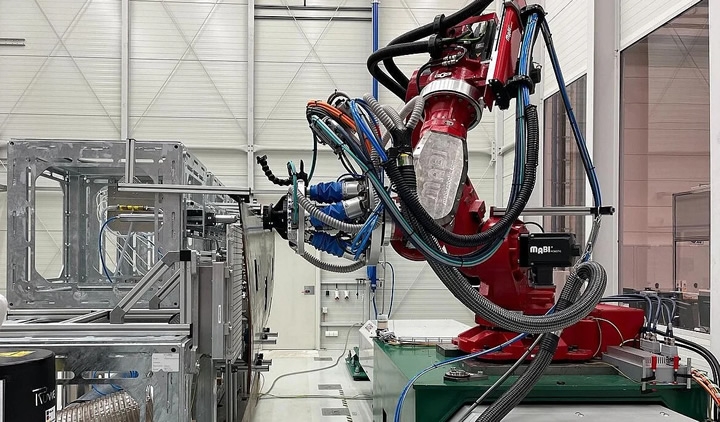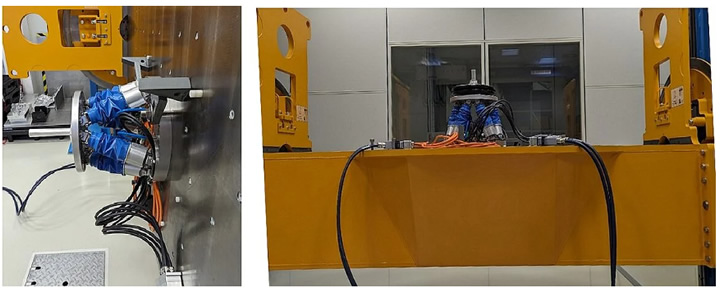PI presented a new, high-speed hexapod at the International Aerospace Exhibition ILA Berlin in June 2024, as a partner in the LuFo VI-1: ADMAS (Advanced Machining and Sealing) research project.
 Fast Hexapod Improves Aircraft Manufacturing Process
Fast Hexapod Improves Aircraft Manufacturing Process

Article from | PI
PI presented a new, high-speed hexapod at the International Aerospace Exhibition ILA Berlin in June 2024, as a partner in the LuFo VI-1: ADMAS (Advanced Machining and Sealing) research project.
As part of the joint project under the leadership of Airbus, and the Fraunhofer IFAM institute, PI developed a compact, high-speed, 6-DOF hexapod for highly dynamic compensation kinematics in aircraft manufacturing processes. The project's goal was to enhance the processing and sealing precision of carbon fiber-reinforced composite (CFRP) components in resin transfer molding (RTM) processes. At the same time, manufacturing times and process costs were supposed to be cut.
Carbon fiber composites combine high stiffness with extremely low weight, helping increase energy efficiency in air travel, a prerequisite in CO2 emission reductions.
Dynamic Compensation of Process Forces
The compensation kinematics focus on improving the contour machining of single-aisle wing shells for the Wing of Tomorrow, made of CFRP, through milling and deburring, followed by sealing and drilling. The H-900K101 PI hexapod, in combination with the coarse motion of a traditional articulated robot, is used for highly dynamic, high-precision positioning of the machining and sealing tools.
With the new H-900K101 hexapod, we have implemented a highly dynamic, multi-axis motion system that can accelerate a payload of up to 40kg in the XY plane at up to 1.2G," says Dr Christian Sander, Head of Technology Development Parallel Kinematics at PI’s headquarters in Karlsruhe, Germany. "The system is able to dynamically compensate for high-frequency path deviations under the influence of process forces during milling." The new design was an improvement on a previous dynamic hexapod with a lower center of mass, reduced operating height, and many other incremental improvements over previous designs.
.jpg)
Dynamic error compensation test with 40kg load (Image: PI)
Fine Positioning of Tools
The newly developed hexapod precision motion system is specifically designed to meet the boundary and environmental conditions of the application, making it particularly optimized for time-critical manufacturing processes with the tight tolerances required by the aerospace industry.

Hexapod test and 0 degree to 90 degree orientation on PI’s high-load swivel bench (Image: PI)
In addition to this high dynamic performance, the hexapod system offers fiber-optic data transmission between the hexapod controller and the driver electronics, enabling a very low latency time when using the EtherCAT® interface and IP54-sealed components. Fiber-optic data transmission allows the hexapod controller to be conveniently located in the control cabinet outside the processing cell without compromising the variety of interfaces while controlling the driver electronics over a distance of up to 100m (330ft). For the EtherCAT® interface, PI has achieved a deep integration of EtherCAT® functionality within its controller and driver architecture. As a result, PI's positioning system contributes only a minimal amount of dead time to the complex control loop for path error compensation between the edge-detection sensor system, the articulated robot, and the hexapod. The response time in the EtherCAT® control loop between the hexapod's position request and position response is a swift 1.5ms.
Condition Monitoring
The ADMAS LuFo project also investigated the use of acceleration sensors for wear detection on individual hexapod struts in the context of condition monitoring. The frequency spectrum of vibrations within each strut can be mapped to characteristic eigenfrequencies of drive components, providing an indicator of system changes and the need for service.
Hexapod Parallel-Kinematic Motion Systems
Hexapods are parallel-kinematic machines and offer motion in six degrees of freedom in a smaller envelope than traditional serial kinematic motion systems. For industrial applications, absolute position sensors for each hexapod strut provide safety and render referencing unnecessary. All coordinate transformations run on the motion controller and user-friendly software allows the execution of complex motion profiles. PI's precision hexapods are available in standard configurations for loads from 10lbs to 1,000lbs with repeatability down to ±0.06μm. Customized precision hexapods can support loads more than 4,000lbs.

Standard hexapod controller (bottom), new compact Hexapod controller (top), and sealed driver box with heat sink (right). Communication between the controller and driver is via fiber-link. (Image: PI)
Under the leadership of Airbus and the IFAM, PI has contributed with its four decades of hexapod design experience to this pioneering research. The project, publicly funded by the German Federal Ministry for Economic Affairs and Climate Protection and overseen by the DLR Project Management Agency for Aviation Research, was successfully completed at the end of April 2024.
The Fraunhofer IFAM institute for manufacturing technology, in Stade, Germany, was tasked with building the overall system demonstrator and addressing the research topics within the project and the individual partners. They were also taking on the role of the overarching project coordinator while applying their valuable application knowledge.
Title Image source: IFAM
The content & opinions in this article are the author’s and do not necessarily represent the views of RoboticsTomorrow

PI USA (Physik Instrumente)
PI is a privately held company that designs and manufactures world-class precision motion and automation systems including air bearings, hexapods and piezo drives at locations in North America, Europe, and Asia. The company was founded 5 decades ago and today employs more than 1700 people worldwide. PI's customers are leaders in high-tech industries and research institutes in fields such as photonics, life-sciences, semiconductors and aerospace.
Other Articles
High-Throughput PIC Production Needs Precision Alignment Equipment for Photonics Arrays, Fibers, Lenses
Fiber Alignment and Photonic Chip Test & Assembly Just Got Easier
Nanopositioning and Motion Control Solutions for the Semiconductor Industry
More about PI USA (Physik Instrumente)
Comments (0)
This post does not have any comments. Be the first to leave a comment below.
Featured Product

